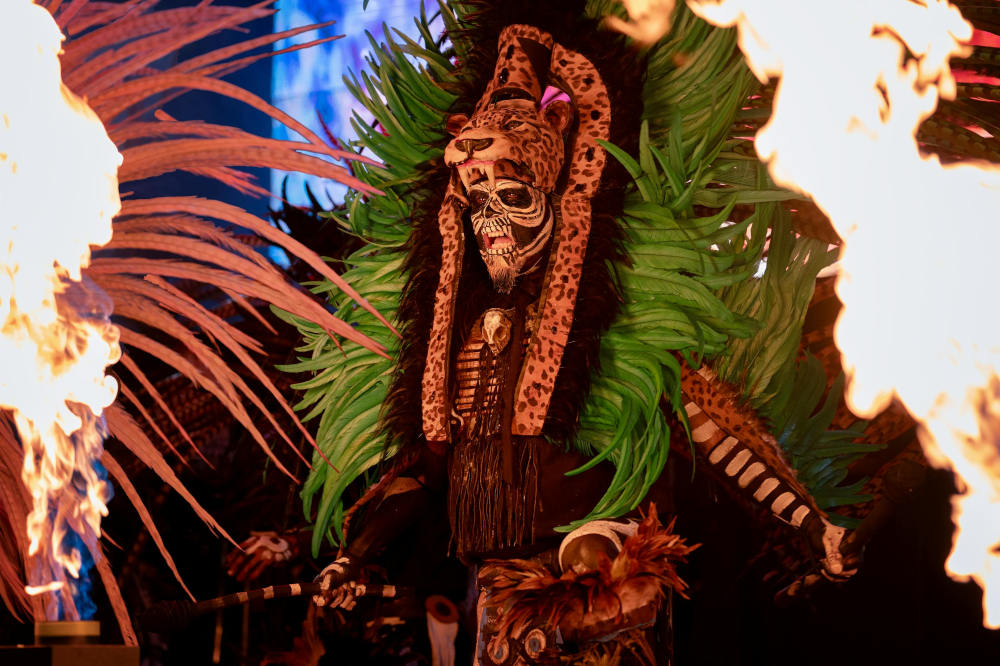
Le chamanisme est l'une des plus anciennes formes de pratique spirituelle de l'histoire de l'humanité, existant bien avant l'essor des religions organisées comme le christianisme, l'islam ou le judaïsme. C'est une forme d'expression spirituelle présente dans les cultures autochtones du monde entier, de la Sibérie à la forêt amazonienne, des traditions amérindiennes aux systèmes tribaux africains. Mais à mesure que les idées spirituelles mondiales s'entremêlent de plus en plus, une question complexe se pose : les chamans croient-ils en Jésus ?
La réponse n'est pas simple : oui ou non. Elle dépend grandement de la géographie, de la culture, des croyances personnelles et de l'influence du chaman sur le christianisme ou sur des pratiques traditionnelles préchrétiennes. Cet article explore la perception de Jésus dans diverses traditions chamaniques, l'intégration de Jésus dans leur vision spirituelle du monde par les chamans et le rôle du syncrétisme – mélange de systèmes de croyances.
Panaprium est indépendant et pris en charge par les lecteurs. Si vous achetez quelque chose via notre lien, nous pouvons gagner une commission. Si vous le pouvez, veuillez nous soutenir sur une base mensuelle. La mise en place prend moins d'une minute et vous aurez un impact important chaque mois. Merci!
1. Qu'est-ce que le chamanisme ?
Avant d'explorer les croyances concernant Jésus, il est essentiel de comprendre ce qu'est le chamanisme. Le chamanisme n'est pas une religion unifiée, dotée d'un texte sacré central ou d'une doctrine universelle. Il s'agit plutôt d'une pratique spirituelle centrée sur l'expérience directe du monde spirituel . Les chamans sont considérés comme des intermédiaires entre les mondes physique et spirituel, pénétrant souvent dans des états de conscience modifiés pour :
-
Communiquez avec les esprits, les ancêtres ou les forces de la nature
-
Effectuer des rituels de guérison
-
Offrir des conseils, de la divination ou de la protection
-
Rétablir l'équilibre entre les individus et les communautés
La plupart des systèmes chamaniques traditionnels sont animistes , ce qui signifie qu’ils croient que tout – animaux, plantes, rochers, rivières – a une essence spirituelle.
2. Qui est Jésus dans la doctrine chrétienne ?
Dans le christianisme, Jésus de Nazareth est considéré comme le Fils de Dieu, la deuxième personne de la Trinité et le sauveur de l'humanité par sa mort et sa résurrection. Les chrétiens voient en Jésus :
-
Le Messie (l'oint)
-
Entièrement divin et pleinement humain
-
Le seul chemin vers le salut et la vie éternelle
-
Un personnage historique qui a vécu en Palestine au premier siècle et a été crucifié sous la domination romaine
La croyance en Jésus est la pierre angulaire de la foi chrétienne. Mais dans le contexte du chamanisme – antérieur de plusieurs milliers d'années au christianisme –, la figure de Jésus est interprétée de diverses manières, voire pas du tout.
3. Visions chamaniques traditionnelles : pas de Jésus dans les cultures préchrétiennes
Dans la majorité des systèmes chamaniques préchrétiens ou autochtones isolés , Jésus ne fait pas partie du cadre spirituel . Ces traditions se sont développées indépendamment de l'influence chrétienne et possèdent souvent leur propre panthéon d'esprits, de divinités, d'ancêtres ou de forces de la nature. Par exemple :
-
Les chamans sibériens communient traditionnellement avec les dieux du ciel, les esprits du monde souterrain et les gardiens animaux.
-
Les chamans amazoniens peuvent invoquer des esprits végétaux comme l'ayahuasca ou des entités de la jungle pour la guérison et les conseils.
-
Les chamans africains (comme les sangomas en Afrique australe) s'appuient sur les esprits ancestraux et les os de divination.
Dans ces formes traditionnelles, Jésus n’apparaît pas dans les rituels ou les systèmes de croyances , non pas parce qu’il est rejeté , mais simplement parce qu’il ne fait pas partie de leur cosmologie indigène .
4. Syncrétisme : quand chamanisme et christianisme s'entremêlent
Cependant, dans les régions où le christianisme s'est répandu, notamment par le biais du colonialisme ou des missions , chamanisme et christianisme se sont souvent entremêlés . Ce processus, connu sous le nom de syncrétisme religieux , a donné naissance à des systèmes hybrides uniques où Jésus peut être accepté ou réinterprété dans un contexte chamanique.
Exemples de traditions syncrétiques :
a) Amérique latine
De nombreuses cultures indigènes d'Amérique latine ont été christianisées par les colons espagnols et portugais. Aujourd'hui, dans des pays comme le Mexique, le Pérou et le Brésil, il n'est pas rare que des curanderos (guérisseurs) ou des chamans invoquent Jésus, la Vierge Marie et des saints aux côtés de divinités et d'esprits indigènes.
Par exemple:
-
Dans la cosmologie andine , Jésus pourrait être considéré comme un être de lumière puissant ou un esprit élevé aligné sur l’harmonie cosmique.
-
Dans les religions afro-brésiliennes comme l'Umbanda, les médiums spirituels peuvent travailler avec des personnalités catholiques tout en canalisant d'autres entités spirituelles.
Dans ces cas, Jésus n’est pas toujours considéré dans un sens chrétien strictement orthodoxe , mais plutôt comme une force puissante parmi tant d’autres.
b) Traditions amérindiennes
Parmi certaines tribus amérindiennes, notamment celles influencées par les missionnaires chrétiens, Jésus a été intégré à leurs enseignements spirituels . L' Église amérindienne , par exemple, associe des éléments chrétiens à l'usage traditionnel du peyotl lors de cérémonies sacrées.
Les membres peuvent prier Jésus comme le Grand Esprit ou le considérer comme un enseignant ou un guide spirituel. Cependant, cela ne correspond pas toujours à la théologie chrétienne dominante et s'enracine souvent dans des visions personnelles et communautaires .
c) Îles du Pacifique et Afrique
Dans de nombreuses régions d' Afrique et des îles du Pacifique , les missionnaires ont introduit le christianisme, tandis que les chamans locaux (parfois appelés guérisseurs ou sorciers) conservaient des éléments de leurs pratiques autochtones. Au fil du temps, Jésus a été intégré comme guérisseur ou figure divine , parfois mêlé à des divinités locales ou à des héros spirituels.
5. New Age et néo-chamanisme : une vision différente de Jésus
Dans les sociétés occidentales, le néo-chamanisme – une adaptation moderne, souvent New Age, des principes chamaniques autochtones – a gagné en popularité. Les adeptes du néo-chamanisme n'appartiennent pas forcément à une tribu ou une culture spécifique, mais s'inspirent de diverses traditions. Dans ce contexte, Jésus est parfois considéré comme un maître spirituel, un être ascensionné ou un guérisseur .
-
Il n’est pas considéré comme le sauveur exclusif, mais comme une âme éclairée parmi d’autres (comme Bouddha ou Krishna).
-
Jésus peut être invoqué dans des rituels de guérison ou des méditations.
-
Ses enseignements (en particulier sur l’amour, le pardon et la paix intérieure) sont appréciés, mais sa divinité ou son exclusivité en tant que Fils de Dieu n’est souvent pas soulignée .
Cette perspective universaliste voit Jésus davantage comme une figure chamanique – quelqu’un qui guérissait, avait des visions, combattait les mauvais esprits et voyageait entre les mondes physique et spirituel.
6. Un chaman peut-il être chrétien ?
Certes, certaines personnes s'identifient à la fois comme chamanes et chrétiens , notamment dans les traditions syncrétiques ou dans les contextes où le christianisme est la religion dominante. Cependant, la compatibilité entre chamanisme et christianisme reste sujette à débat :
-
Certains chrétiens considèrent le chamanisme comme incompatible avec la Bible, citant des versets qui condamnent la sorcellerie, la divination et la communication avec les esprits.
-
D’autres soutiennent que les pratiques chamaniques peuvent être repensées comme des guérisons guidées par l’Esprit, surtout si elles sont débarrassées de toute croyance polythéiste ou animiste.
Certains mystiques chrétiens et dirigeants charismatiques ont même établi des comparaisons entre les miracles de Jésus et les actes chamaniques, tels que la guérison des malades, l'expulsion des démons et les visions spirituelles.
7. Controverse et critique
Alors que certaines personnes adhèrent à la fusion de la spiritualité chamanique avec les idées chrétiennes, d’autres la critiquent car elle dilue ou déforme les deux traditions .
-
Les chrétiens traditionnels considèrent souvent le chamanisme comme dangereux, non biblique, voire démoniaque.
-
Les chamans traditionnels peuvent résister à l’intégration de figures chrétiennes comme Jésus, les considérant comme des impositions étrangères ou coloniales.
-
Les théologiens et les universitaires mettent en garde contre l’appropriation culturelle ou la simplification excessive des croyances autochtones.
8. Réflexions finales : un spectre de croyances
Alors, les chamans croient-ils en Jésus ?
La réponse la plus précise est : certains le croient, d’autres non, et beaucoup le perçoivent différemment des chrétiens orthodoxes . La croyance en Jésus chez les chamans est très diversifiée :
-
Les chamans traditionnels des régions isolées peuvent ne pas connaître Jésus ou ne pas s’en soucier.
-
Les chamans syncrétiques peuvent le voir comme un esprit puissant, un guérisseur ou un enseignant.
-
Les néo-chamans peuvent le vénérer comme un être éclairé ou un modèle.
-
Les chamans chrétiens tentent de concilier les deux systèmes de croyances de manière personnelle ou culturelle.
En fin de compte, la place de Jésus dans les traditions chamaniques reflète la nature diversifiée, évolutive et profondément personnelle de la spiritualité à travers le monde.
Références
-
Hultkrantz, Åke. Guérison chamanique et christianisme dans les cultures autochtones . Brill, 1996.
-
Eliade, Mircea. Chamanisme : techniques archaïques de l’extase . Presses universitaires de Princeton, 1964.
-
Narby, Jeremy. Le Serpent cosmique : l’ADN et les origines de la connaissance . Tarcher, 1998.
-
Wallis, Robert J. Chamans/Néo-chamans : extase, archéologies alternatives et païens contemporains . Routledge, 2003.
-
Harvey, Graham. Animisme : respecter le monde vivant . Columbia University Press, 2006.
Cet article vous a-t-il été utile ? S'il vous plaît dites-nous ce que vous avez aimé ou n'avez pas aimé dans les commentaires ci-dessous.
About the Author: Alex Assoune
Contre Quoi Nous Luttons
Les groupes multinationaux surproduisent des produits bon marché dans les pays les plus pauvres.
Des usines de production où les conditions s’apparentent à celles d’ateliers clandestins et qui sous-payent les travailleurs.
Des conglomérats médiatiques faisant la promotion de produits non éthiques et non durables.
De mauvais acteurs encourageant la surconsommation par un comportement inconscient.
- - - -
Heureusement, nous avons nos supporters, dont vous.
Panaprium est financé par des lecteurs comme vous qui souhaitent nous rejoindre dans notre mission visant à rendre le monde entièrement respectueux de l'environnement.
Si vous le pouvez, veuillez nous soutenir sur une base mensuelle. Cela prend moins d'une minute et vous aurez un impact important chaque mois. Merci.
































0 commentaire